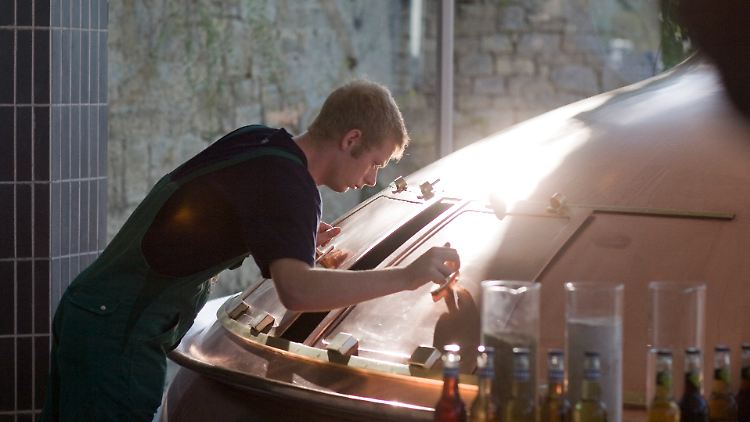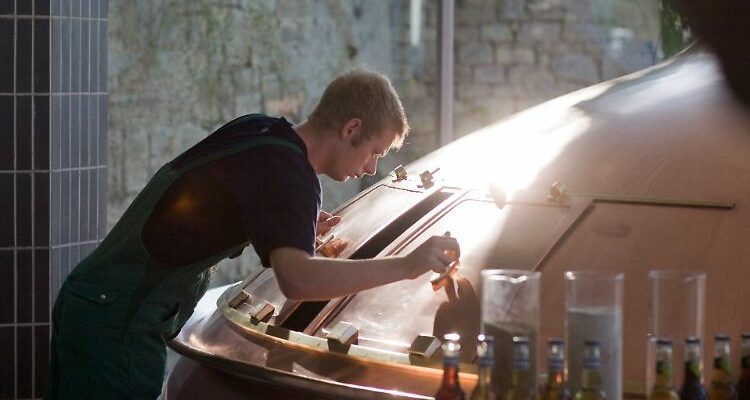In February 1994, a Bavarian brewer invented something new – a fruity, low-sugar and vegan lemonade. Winning the lottery saves him from ruin and makes his vision possible. The Bionade became cult and many companies are still trying to profit from the supposedly healthy drinks trend.
A look into a drinks market looks different today than it did in the 1980s. Where there used to be beer, water, juice and cola, there is now an almost unmanageable variety of colorful lemonades, fizzy drinks and soft drinks. Fritzlimo, Club-Mate, Fassbrause, Frohlunder, Lemonaid, Proviant, Now – many lemonades want to be much more than just a thirst quencher, a statement for a conscious lifestyle. And they are no longer just aimed at young people, but at adults.
Fruity lemonades seem to be particularly popular in big cities. But the trend had its origins in the Franconian province. 30 years ago, on February 24th, master brewer Dieter Leipold from the 3,000-inhabitant town of Ostheim vor der Rhön applied for the patent for a new soda: Bionade.
Soda wasn’t initially seen as soda
“What set Bionade apart at the time was that it was not perceived as lemonade at all,” says psychologist and market researcher Jens Lönneker from the Cologne market research institute Rheingold Salon. Cola and Fanta were already frowned upon as being too sweet. But with Bionade the shyness fell away: natural production, less sweet, smaller bottles than typical lemonades. “From the point of view of many consumers, this was a completely new category of drinks,” says Lönneker.
According to the company, Leipold had been working on a new drink since the 1960s. But in the 90s the idea gained particular momentum. The Peter family brewery in the Bavarian Rhön was doing poorly economically. Beer consumption in Germany is still declining today. While in 2013 each citizen drank an average of 99 liters, in 2023 the figure was 83 liters. The declining trend was already evident in the 1990s.
For Bionade, Leipold used his beer brewing knowledge: Bionade is also brewed with barley malt. Except that no alcohol is produced. Following the example of bees, sugar is converted into gluconic acid through fermentation. The bottle is also based on the shape of a classic beer bottle.
Lottery winnings invested in Bionade
The story of Bionade has something like a fairytale: a family business is fighting for survival. Here comes the saving idea. But she is initially misunderstood. The big breakthrough is yet to come. Then Leipold’s wife wins the lottery and puts the money into the company. This is followed by a new design, the first drinks wholesaler and finally Bionade becomes cult. From the Bavarian province to the trendy clubs across the country. That’s roughly the story that Bionade likes to tell.

A master brewer from Bionade GmbH looks into a brew kettle – this is where the liquid and solid components are separated
(Photo: picture alliance / photothek)
The drink idea now also secures the income of farmers in the area. Many fields in the area have become elderberry fields. According to the company, elderberry is the most popular variety. Other varieties that were not conceivable for lemonade 40 years ago include lychee, herbs, orchards and lemon bergamot.
Bionade is now no longer independent. With a detour via the Radeberger Group, which is part of the Oetker Group, the brand has been part of the Hessian Hassia Group since 2018. Despite rollercoaster rides with temporary drops in demand, Bionade continues to appear successful: in 2022, the brand says it achieved a sales increase of six percent.
Between organic and Biedermeier
“Bionade was a completely new type of soft drink. With its low calorie content, it was very ahead of the times,” says Detlef Gross, managing director of the German Association for Non-Alcoholic Drinks (WAFG), based in Berlin. Many other beverage manufacturers followed suit. Bionade took legal action against visually similar products. But other non-alcoholic trendy drinks also became popular. In 2010, the Cologne brewery Gaffel came onto the market with a barrel brewer. Club-Mate began to compete with Cola as a caffeinated drink.
Some manufacturers have gone one better and presented themselves even more ethically: the new sodas should not only be organic, but also fairly produced and sustainable. Vegan anyway. Drinking for a better world, so to speak. Bionade is also committed to biodiversity and environmental education and has been purchasing CO2-neutral electricity for years. Fritz-Kola came around the corner with a “Drink from Glass” campaign against plastic waste. Some manufacturers such as Lemonaid and the Premium Collective joined forces in 2010 to form an “Association of Correct Drinks Manufacturers” – of which, however, we no longer hear or read anything.
The target group of the “good limos” are, among others, the so-called LOHAS (Lifestyle of Health and Sustainability). People who want to live healthy and sustainably. Often meant in a derogatory way, the term “Bionade-Biedermeier” has been used for years to describe well-off city dwellers who position themselves politically through sustainable consumption. According to a Yougov survey, the proportion of vegetarians and vegans among Fritz Kola customers is 50 percent higher than in the general population.
Selling indulgences in the drinks market
It may be questionable how healthy the trendy limos really are. Some of them contain less sugar than soft drinks from the 80s. Some of the cult drinks aren’t even officially a soda. Because for a soda, the sugar content actually has to be at least seven percent. But the “new” drinks also contain several grams of sugar.
Marketing makes a difference, says psychologist Lönneker. He compares it to selling indulgences. “With the drinks you are one of the good guys again and can still drink the delicious stuff that you previously rejected as unhealthy,” says Lönneker. He sees similar so-called rationalizations with meat alternatives.
“Start-ups with the garage founder mentality often have a hard time”
According to Wafg, there is no exact number of how many products are offered as sodas and similar non-alcoholic drinks in Germany. “We have a large number of new product launches, but only a few can hold their own on the market,” says Managing Director Gross. The effort required to get started on the market is great. The key to success is a good product, but you also have to be familiar with food and packaging law. In addition, the lemonade market is not a niche market. In addition to international corporations, mineral springs, breweries and regional manufacturers got involved. “Start-ups with the garage founder mentality often have a hard time,” says Gross.
In addition to sodas, soft drinks also include other trendy products such as iced teas and energy drinks. Water with fruit additives – now called “near-water” products – are also increasingly entering the beverage markets. According to Wafg, low-calorie drinks are particularly popular, but classic colas and sodas make up the majority of the market. Germans drink around 80 liters of sodas and colas per person per year, according to Wafg figures. There are also around six liters of spritzers, water with flavors, energy drinks and fizzy drinks as well as ten liters of fruit juice drinks.
Psychologist Lönneker sees waves in the market that last around seven to ten years: sometimes the trend is more towards abstinence and water, other times more towards gluttony and flavored, sweet drinks “When life seems difficult, you want to “A lot of people treat themselves to drinks,” says Lönneker. In view of social challenges such as wars, climate change and political unrest, he is currently seeing a trend to sweeten one’s life. Of course with a clear conscience.
